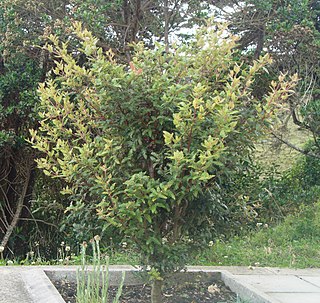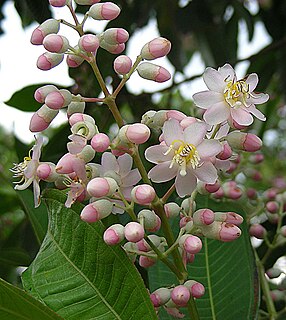
Paulownia tomentosa, common names princess tree, empress tree, or foxglove-tree, is a deciduous tree in the family Paulowniaceae, native to central and western China. It is an extremely fast-growing tree with seeds that disperse readily, and is a persistent exotic introduced species in North America, where it has undergone naturalisation in large areas of the Eastern US. P. tomentosa has also been introduced to Western and Central Europe, and is establishing itself as a naturalised species there as well.

Miconia is a genus of flowering plants in the glory bush family, Melastomataceae, native to warm temperate to tropical regions of the Americas. The species are mostly shrubs and small to medium-sized trees up to 15 m tall. The generic name honours Catalan physician and botanist Francesc Micó. Some species are known by the common name johnnyberry.

The South American coati, also known as the ring-tailed coati, and called quati in Portuguese, is a coati species and a member of the raccoon family (Procyonidae), found in the tropical and subtropical parts of South America. An adult generally weighs from 2–7.2 kg (4.4–15.9 lb) and is 85–113 cm (33–44 in) long, with half of that being its tail. Its colour is highly variable and the rings on the tail may be only somewhat visible, but its most distinguishing characteristic is that it lacks the largely white snout of its northern relative, the white-nosed coati.

Aglaia tomentosa is a species of plant in the family Meliaceae. It is found in Australia (Queensland), Brunei, India, Indonesia, Laos, Malaysia, Papua New Guinea, the Philippines, Singapore, and Vietnam.
Ficus pulchella is a species of tree in the family Moraceae. It is native to South America.
Miconia aligera is a species of plant in the family Melastomataceae. It is endemic to Peru.
Miconia brevistylis is a species of plant in the family Melastomataceae. It is endemic to Peru.
Miconia calophylla is a species of plant in the family Melastomataceae. It is endemic to Peru.
Miconia centrosperma is a species of plant in the family Melastomataceae. It is endemic to Panama. It is threatened by habitat loss.
Miconia perelegans is a species of plant in the family Melastomataceae. It is endemic to Cuba.
Miconia poecilantha is a species of plant in the family Melastomataceae. It is endemic to Colombia.
Miconia santaritensis is a species of plant in the family Melastomataceae. It is endemic to Panama. It is threatened by habitat loss.
Miconia setulosa is a species of plant in the family Melastomataceae. It is endemic to Peru & Bolivia.
Miconia silicicola is a species of plant in the family Melastomataceae. It is found in Guyana and Venezuela.

Weinmannia tomentosa, the encenillo, is a tree native of the highlands of the Andean region of Colombia, which belongs to the family Cunoniaceae. A synonym for Weinmannia tomentosa is Windmannia tomentosa.

Tilia tomentosa, known as silver linden in the US and silver lime in the UK, is a species of flowering plant in the family Malvaceae, native to southeastern Europe and southwestern Asia, from Romania and the Balkans east to western Turkey, occurring at moderate altitudes.

Miconia prasina is a species of tree in the family Melastomataceae. It is native to Mexico, Central America, the Caribbean and South America.

Miconia theaezans is a species of shrub or tree in the family Melastomataceae. It is native to South America.

Miconia holosericea is a species of shrub or tree in the family Melastomataceae. It is native to North and South America.

Miconia minutiflora is a species of tree in the family Melastomataceae. It is native to North and South America.





